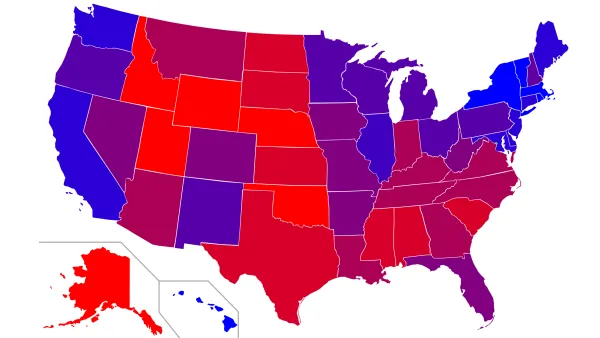New Census data shows that after a recession induced respite, "Americans have resumed moving from the Northeast and Midwest to the West and South," reports Neil Shah. Four of the nation's fastest growing large metro areas are located in Texas.
"Forty of the 50 fastest-growing metropolitan areas in the U.S. last year were in the South or West, according to a Census report to be published Thursday," writes Shah. "Of the 20 counties that saw the biggest inflows of people relative to their populations, 19 were in the West, the South or Great Plains states such as North Dakota. Meanwhile, metro areas in the Northeast and Midwest including Detroit and Philadelphia saw relatively large outflows of people between July 2011 and July 2012, the Census report shows."
"The fact that more Americans are now moving west and south could reflect improved hiring and suggests fewer people are stuck in one place because they owe more on their mortgages than their homes are worth," he adds. "Separate Census figures recently showed around 4% of the U.S. population moved to a different county in 2011, the highest level since before the recession."
"The dam has broken on the pent-up demand for migration," demographer William Frey of the Brookings Institution said. "There is the beginning of a shift back to the Sunbelt, as many Snowbelt movers who were frozen in place are now moving to South and West metropolitan areas."
An article on the new figures in The Washington Post, which notes that the region's remarkable growth has slowed considerably, shows a ranking of the 15 fastest growing large metros.
FULL STORY: Americans on the Move Again

National Parks Layoffs Will Cause Communities to Lose Billions
Thousands of essential park workers were laid off this week, just before the busy spring break season.

Retro-silient?: America’s First “Eco-burb,” The Woodlands Turns 50
A master-planned community north of Houston offers lessons on green infrastructure and resilient design, but falls short of its founder’s lofty affordability and walkability goals.

Delivering for America Plan Will Downgrade Mail Service in at Least 49.5 Percent of Zip Codes
Republican and Democrat lawmakers criticize the plan for its disproportionate negative impact on rural communities.

Test News Post 1
This is a summary

Test News Headline 46
Test for the image on the front page.

Balancing Bombs and Butterflies: How the National Guard Protects a Rare Species
The National Guard at Fort Indiantown Gap uses GIS technology and land management strategies to balance military training with conservation efforts, ensuring the survival of the rare eastern regal fritillary butterfly.
Urban Design for Planners 1: Software Tools
This six-course series explores essential urban design concepts using open source software and equips planners with the tools they need to participate fully in the urban design process.
Planning for Universal Design
Learn the tools for implementing Universal Design in planning regulations.
EMC Planning Group, Inc.
Planetizen
Planetizen
Mpact (formerly Rail~Volution)
Great Falls Development Authority, Inc.
HUDs Office of Policy Development and Research
NYU Wagner Graduate School of Public Service





























